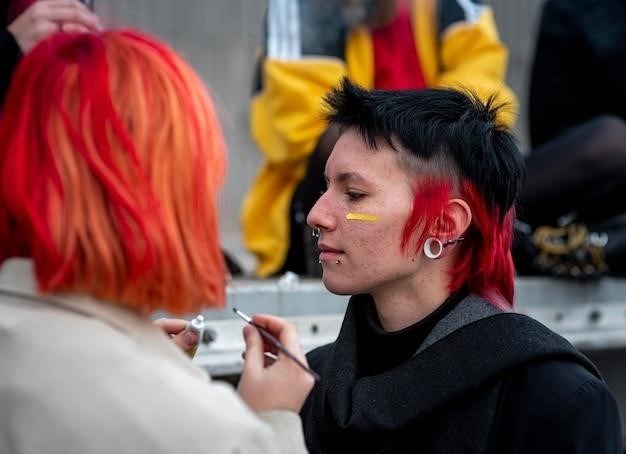Face Piercing Guide⁚ A Comprehensive Overview
This guide explores the world of face piercings‚ from choosing the right piercing and understanding aftercare to selecting a reputable piercer and maintaining hygiene. Learn about popular piercing types‚ healing times‚ and how to deal with potential complications. Make an informed decision and enjoy your new look!
Choosing the Right Piercing
Selecting your first (or next!) face piercing involves careful consideration of several factors. Firstly‚ assess your pain tolerance. Some piercings‚ like nostril piercings‚ are generally considered less painful than others‚ such as eyebrow piercings. Research the healing times associated with different piercings; some heal quickly (e.g.‚ septum piercings)‚ while others require significantly longer healing periods (e.g.‚ industrial piercings). Your anatomy also plays a crucial role. Certain piercings may not be suitable for everyone based on the structure of their face or the thickness of their skin. Consider your personal style and the overall aesthetic you want to achieve. Do you prefer a subtle look or something bolder and more dramatic? Browse images of different face piercings to find inspiration and see what complements your facial features. Finally‚ consult with a reputable piercer. They can provide professional guidance‚ assess your suitability for various piercings‚ and help you make the best choice for your unique situation.
Popular Face Piercing Types and Their Placement
Numerous face piercing options cater to diverse aesthetics. The nostril piercing‚ adorning the side of the nose‚ offers a classic and versatile choice. A septum piercing‚ situated through the thin piece of cartilage separating the nostrils‚ provides a bold statement. Eyebrow piercings‚ placed along the eyebrow’s arch‚ add an edgy touch. Lip piercings‚ including the labret (lower lip)‚ Monroe (above the lip’s corner)‚ and Medusa (in the center of the upper lip)‚ offer a range of expressive styles. Cheek piercings‚ subtly placed on the cheek‚ provide a unique and less common option. Bridge piercings‚ positioned across the bridge of the nose‚ offer a modern and minimalist look. For a more dramatic effect‚ consider the daith piercing‚ located in the inner ear’s cartilage‚ or the industrial piercing‚ connecting two points of the upper ear cartilage. Each piercing’s placement significantly impacts the overall appearance and should align with individual preferences and facial features. Remember to discuss placement options with your piercer to ensure the best possible result.
Understanding Piercing Aftercare
Proper aftercare is crucial for a successful face piercing healing process. This involves meticulous cleaning to prevent infection and promote healing. Your piercer will provide specific instructions tailored to your piercing type‚ but general guidelines include washing your hands thoroughly before touching the piercing. Gentle cleaning twice daily with a saline solution‚ as recommended by your piercer‚ is vital. Avoid harsh soaps‚ lotions‚ or makeup near the piercing site. Keep the area dry‚ and avoid harsh scrubbing. Refrain from touching or playing with the jewelry‚ as this can introduce bacteria and delay healing. Be mindful of potential complications like swelling‚ redness‚ or discharge‚ and contact your piercer immediately if you notice anything unusual. Following your piercer’s instructions carefully and maintaining good hygiene will significantly improve the healing process and minimize the risk of complications. Remember that healing times vary‚ so patience is key. Regular monitoring and proactive care will greatly enhance your piercing healing experience.
Daily Cleaning and Maintenance

Maintaining a clean piercing is paramount to preventing infection and ensuring proper healing. Begin by thoroughly washing your hands with antibacterial soap before touching your piercing. Use a saline solution‚ as recommended by your piercer‚ to gently cleanse the area twice daily. Avoid harsh soaps or cleansers that could irritate the sensitive skin around the piercing. Apply the saline solution using a clean cotton swab or gauze pad‚ carefully cleaning both the entry and exit points of the piercing. Rinse the area thoroughly with warm water to remove any remaining solution. Avoid over-cleaning‚ as this can irritate the piercing and hinder healing. Pat the area dry with a clean paper towel‚ avoiding harsh rubbing. During the healing process‚ it’s essential to keep the piercing dry as much as possible. Avoid submerging the piercing in water‚ such as swimming pools or hot tubs‚ and try to protect it from contact with makeup‚ hair products‚ or other potential irritants. Be gentle and patient‚ allowing the piercing to heal naturally. Consistent daily cleaning is vital for successful healing and reduces the risk of complications.
Dealing with Complications⁚ Swelling‚ Infection‚ and Rejection
While most piercings heal without issue‚ complications can arise. Initial swelling and tenderness are normal‚ but excessive swelling or persistent redness could indicate infection. Signs of infection include increased pain‚ warmth‚ pus‚ or fever. If you suspect an infection‚ immediately consult your piercer or a doctor; They may prescribe antibiotics or other treatments. Rejection‚ where the body pushes out the piercing‚ is more common with certain types‚ such as dermal piercings. Symptoms include increased migration of the jewelry‚ persistent inflammation‚ or the piercing visibly moving. Rejection isn’t usually painful but requires professional attention. Proper aftercare significantly minimizes these risks. Continue diligent cleaning with saline solution. Avoid touching the piercing unnecessarily. Refrain from using harsh chemicals or makeup near the area. If complications occur despite proper care‚ seek professional medical help without delay. Prompt treatment improves the chances of a successful outcome and minimizes potential scarring.
Jewelry Selection and Changes

Choosing the right jewelry is crucial for both aesthetics and healing. Your piercer will advise on appropriate materials for your initial piercing. Biocompatible metals like implant-grade titanium‚ niobium‚ or 14k or 18k gold are generally preferred‚ as they minimize the risk of allergic reactions or irritation during the healing process. Avoid cheaper metals such as nickel or stainless steel‚ which are more likely to cause irritation. The initial jewelry’s size and shape are also important factors‚ as they shouldn’t impede healing or put undue pressure on the piercing. Once your piercing has fully healed (the timeframe varies depending on the type of piercing)‚ you can consider changing jewelry. However‚ always consult your piercer before changing jewelry‚ as improper techniques can lead to complications. They can guide you on suitable jewelry types and how to safely change it. They can also assess whether the piercing is fully healed enough to switch. Ensure the new jewelry is clean and of high quality to maintain the piercing’s health and appearance. Remember‚ patience is key; avoid prematurely altering your jewelry to prevent unnecessary problems.
Healing Times for Different Face Piercings
Healing times for face piercings vary significantly depending on the location‚ type of piercing‚ and individual factors like overall health and aftercare practices. Generally‚ simple piercings like earlobe piercings heal relatively quickly‚ typically within 6-8 weeks. However‚ more complex piercings such as those involving cartilage (like helix or tragus piercings) or those near mucous membranes (like lip or nostril piercings) can take significantly longer to heal‚ often ranging from 3 to 6 months or even longer. Surface piercings‚ which are placed on the skin’s surface rather than through it‚ have a higher rejection rate and often require more extended healing periods. Internal piercings‚ such as those located in the mouth‚ usually heal in 2-3 months‚ while others can take up to 12 months. Factors like adherence to aftercare instructions‚ avoidance of irritation‚ and overall health significantly influence the healing process. Always consult your piercer for specific estimates based on your chosen piercing and your body’s response. Remember‚ complete healing is crucial before making any jewelry changes.
The Importance of Choosing a Reputable Piercer
Selecting a reputable piercer is paramount for a safe and successful piercing experience. A qualified professional prioritizes hygiene and safety‚ using sterilized equipment and following proper piercing techniques to minimize infection risk. Reputable piercers are knowledgeable about anatomy and piercing placement‚ ensuring the piercing is done correctly to promote optimal healing and reduce complications. They’ll provide detailed aftercare instructions tailored to your specific piercing and address any concerns you may have. Look for piercers who are licensed and adhere to strict hygiene protocols. Check reviews and testimonials from previous clients to gauge their experience and professionalism. Don’t hesitate to ask questions about their sterilization procedures‚ experience‚ and aftercare recommendations. Choosing a reputable piercer not only ensures a smoother piercing process but also significantly reduces the risk of infections‚ scarring‚ or other potential problems. A skilled piercer is invested in your well-being and will guide you through every step.
Finding a Qualified Professional
Finding a qualified piercer involves more than just searching online. Begin by asking for recommendations from friends or researching local studios with positive reviews. Look for piercers who are licensed and certified‚ indicating adherence to safety and hygiene standards. Check if they use sterile‚ single-use needles and equipment‚ a crucial factor in preventing infections. Observe the studio’s cleanliness and organization; a well-maintained studio suggests a commitment to hygiene. A consultation before the piercing is essential. A skilled piercer will discuss your desired piercing‚ assess your anatomy‚ and explain the procedure and aftercare thoroughly. They should address your concerns and answer your questions patiently. Don’t hesitate to ask about their experience‚ training‚ and sterilization techniques. Compare prices and services between different studios‚ but prioritize quality and safety over cost. Remember‚ a qualified piercer is an investment in your health and the longevity of your piercing. Choosing wisely ensures a positive experience and reduces potential complications.
Aftercare Products and Solutions
Proper aftercare is crucial for a successful piercing experience. Your piercer will likely recommend specific products‚ but generally‚ a saline solution is the cornerstone of aftercare. This is a sterile solution‚ often available at pharmacies‚ that gently cleanses the piercing without harsh chemicals. Avoid using harsh soaps‚ alcohol‚ or hydrogen peroxide‚ as these can irritate the delicate skin and hinder healing. Some piercers may suggest a specialized aftercare spray or ointment‚ but always confirm its suitability with your piercer. Gentle cleansing twice daily with saline solution is typically sufficient. Avoid excessive touching or rotating the jewelry‚ which can introduce bacteria and prolong healing. If your piercer recommends a particular aftercare solution‚ carefully follow their instructions. Pay attention to the concentration and application method. Should any irritation or infection occur‚ contact your piercer immediately for advice before using any over-the-counter remedies. Remember that consistent and gentle aftercare is key to a smooth healing process and a beautiful‚ healthy piercing.
Maintaining Hygiene and Preventing Infections
Preventing infection is paramount during the healing process of a face piercing. Maintaining impeccable hygiene starts with thoroughly washing your hands before touching the piercing‚ even during cleaning. Avoid touching the piercing unnecessarily; excessive handling introduces bacteria. Keep the piercing area clean and dry‚ but avoid over-cleaning‚ which can irritate the skin. Use only the aftercare products recommended by your piercer‚ and follow their instructions precisely. Avoid using makeup‚ lotions‚ or other products directly on the piercing site‚ particularly during the initial healing phase‚ as these can clog pores and impede healing. Similarly‚ hair products should be kept away from the piercing to minimize the risk of irritation and infection. Pay close attention to any signs of infection‚ such as increased redness‚ swelling‚ pain‚ or pus. If you notice any of these symptoms‚ contact your piercer immediately. Prompt treatment is crucial to prevent the infection from spreading. Remember‚ consistent hygiene practices are crucial for a smooth healing process‚ and contribute significantly to the long-term health and appearance of your new piercing.
